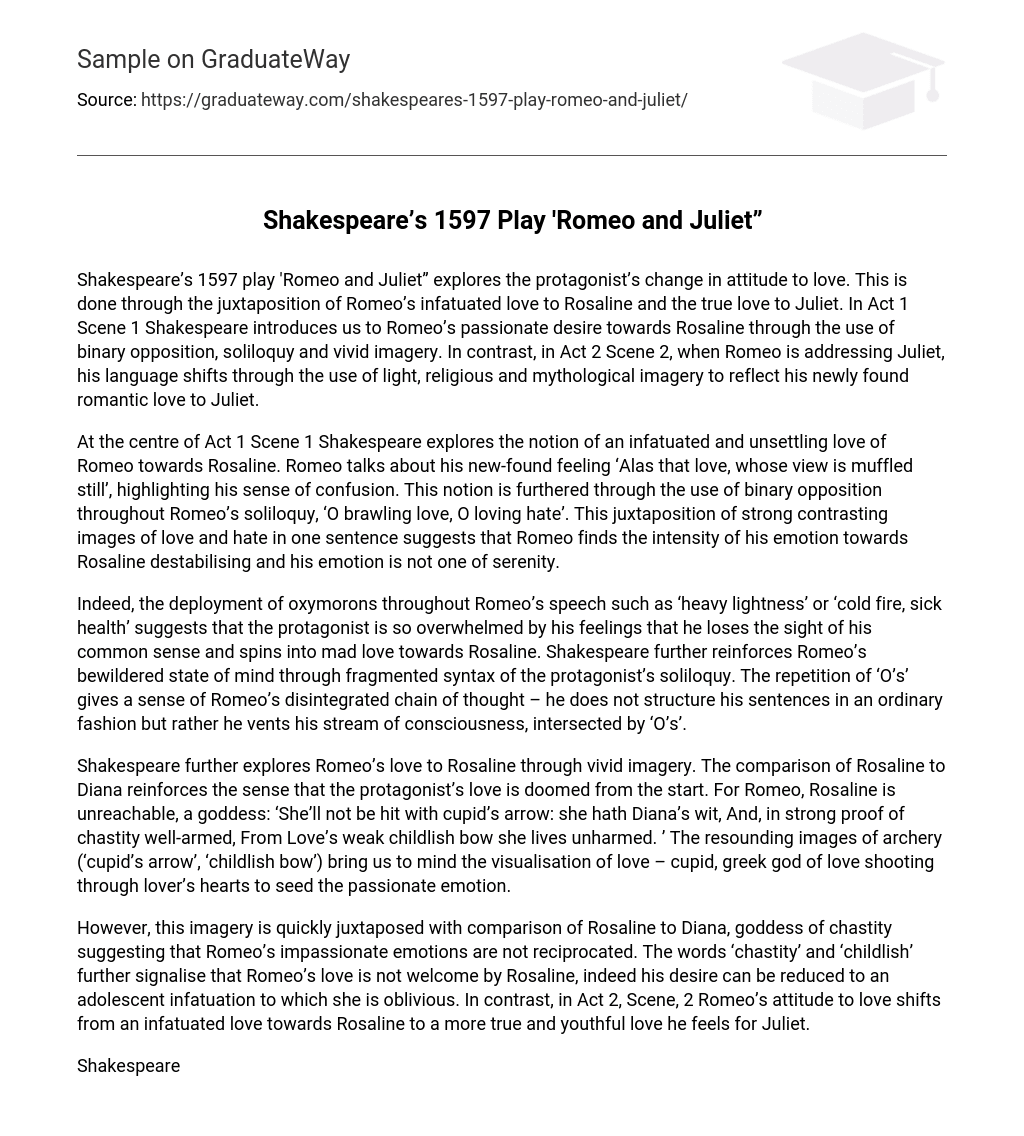Shakespeare’s 1597 play ‘Romeo and Juliet” explores the protagonist’s change in attitude to love. This is done through the juxtaposition of Romeo’s infatuated love to Rosaline and the true love to Juliet. In Act 1 Scene 1 Shakespeare introduces us to Romeo’s passionate desire towards Rosaline through the use of binary opposition, soliloquy and vivid imagery. In contrast, in Act 2 Scene 2, when Romeo is addressing Juliet, his language shifts through the use of light, religious and mythological imagery to reflect his newly found romantic love to Juliet.
At the centre of Act 1 Scene 1 Shakespeare explores the notion of an infatuated and unsettling love of Romeo towards Rosaline. Romeo talks about his new-found feeling ‘Alas that love, whose view is muffled still’, highlighting his sense of confusion. This notion is furthered through the use of binary opposition throughout Romeo’s soliloquy, ‘O brawling love, O loving hate’. This juxtaposition of strong contrasting images of love and hate in one sentence suggests that Romeo finds the intensity of his emotion towards Rosaline destabilising and his emotion is not one of serenity.
Indeed, the deployment of oxymorons throughout Romeo’s speech such as ‘heavy lightness’ or ‘cold fire, sick health’ suggests that the protagonist is so overwhelmed by his feelings that he loses the sight of his common sense and spins into mad love towards Rosaline. Shakespeare further reinforces Romeo’s bewildered state of mind through fragmented syntax of the protagonist’s soliloquy. The repetition of ‘O’s’ gives a sense of Romeo’s disintegrated chain of thought – he does not structure his sentences in an ordinary fashion but rather he vents his stream of consciousness, intersected by ‘O’s’.
Shakespeare further explores Romeo’s love to Rosaline through vivid imagery. The comparison of Rosaline to Diana reinforces the sense that the protagonist’s love is doomed from the start. For Romeo, Rosaline is unreachable, a goddess: ‘She’ll not be hit with cupid’s arrow: she hath Diana’s wit, And, in strong proof of chastity well-armed, From Love’s weak childlish bow she lives unharmed. ’ The resounding images of archery (‘cupid’s arrow’, ‘childlish bow’) bring us to mind the visualisation of love – cupid, greek god of love shooting through lover’s hearts to seed the passionate emotion.
However, this imagery is quickly juxtaposed with comparison of Rosaline to Diana, goddess of chastity suggesting that Romeo’s impassionate emotions are not reciprocated. The words ‘chastity’ and ‘childlish’ further signalise that Romeo’s love is not welcome by Rosaline, indeed his desire can be reduced to an adolescent infatuation to which she is oblivious. In contrast, in Act 2, Scene, 2 Romeo’s attitude to love shifts from an infatuated love towards Rosaline to a more true and youthful love he feels for Juliet.
Shakespeare uses literary devices such as celestial and religious imagery to portray this change. When Romeo for the first time sets his eyes on Juliet he uses light imagery to express his feelings ‘arise, fair sun, and kill the envious moon’. For Romeo, Juliet is the sun who has brought brightness into his life. This beautifully romantic imagery highlights the purity of Romeo’s feelings and underscores to the reader the powerful force of love that Romeo is now entangled in. Moreover, Shakespeare uses religious imagery to underscore purity and strength of Romeo’s feelings.
The protagonist refers to Juliet as a ‘bright angel’, who is ‘a winged messenger of heaven’ and as a ‘dear saint’. This religious imagery underscores the perfection of Romeo’s love to Juliet – just as angels and saints are good and perfect, to Romeo, she is so too. Interestingly, in Act 2 Scene 2 Romeo’s syntax becomes more structured and less broken down by the constant repetition of ‘o’ – ‘the brightness of her cheek would shame those stars/As daylight doth a lamp; her eye in heaven/Would through the airy region stream so bright’.
Through change in syntax, Shakespeare signals to the reader Romeo’s changed attitude to love – he is no longer bewildered, but he is ascertained in his strong and passionate feeling to Juliet. Finally, Romeo’s blind love towards Juliet is underscored by the use of dramatic irony in Act 2 Scene 2, adding suspense and tension to the play. Romeo says, ‘henceforth I never will be Romeo’, ‘my name dear saint is hateful to myself because it is an enemy to thee’.
Through this, Romeo denies that he is a Montague and is keen to break the links to his family for his newly found love, Juliet. Although Romeo is hopeful about the future and blindly in love with Juliet. the audience knows that changing his name will make no difference to the feud between the Capulets and the Montagues, resulting in death of ‘star cross’d lovers’ at the end of the play. This tension between Romeo’s impassionate soliloquy to Juliet and audience’s sense of tragic ending highlights the purity of his love towards Juliet.





